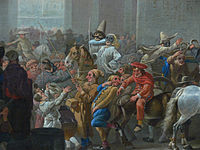Mardi Gras
| Mardi Gras | |
|---|---|
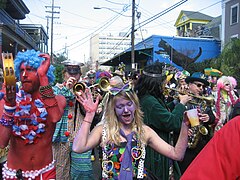 Celebrations in New Orleans, Louisiana, U.S. | |
| Also called | Fat Tuesday, Shrove Tuesday, Pancake Tuesday |
| Type | Christian, Cultural |
| Significance | Celebration period before fasting season of Lent |
| Celebrations | Parades, parties |
| Date | Day before Ash Wednesday, 47 days before Easter, 2 days after Shrove Sunday |
| 2020 date | February 25 |
| 2021 date | February 16 |
| 2022 date | March 1 |
| 2023 date | February 21 |
| Frequency | Annual |
| Related to | Shrove Tuesday, Carnival, Shrove Monday, Shrovetide, Ash Wednesday, Lent, Užgavėnės, Maslenitsa, |
Mardi Gras (/ˈmɑːrdi ˌɡrɑː/), or Fat Tuesday, refers to events of the Carnival celebration, beginning on or after the Christian feasts of the Epiphany (Three Kings Day) and culminating on the day before Ash Wednesday, which is known as Shrove Tuesday. Mardi Gras is French for "Fat Tuesday", reflecting the practice of the last night of eating rich, fatty foods before the ritual Lenten sacrifices and fasting of the Lenten season.
Related popular practices are associated with Shrovetide celebrations before the fasting and religious obligations associated with the penitential season of Lent. In countries such as the United Kingdom, Mardi Gras is also known as Shrove Tuesday, which is derived from the word shrive, meaning "to administer the sacrament of confession to; to absolve".[1]
History
Some think Mardi Gras may be linked[2] with the ancient Roman pagan celebrations of spring and fertility such as Saturnalia, which dates back to 133–31 BC. This celebration honored the god of agriculture, Saturn. It was observed in mid-December, before the sowing of winter crops. It was a week-long festival when work and business came to a halt. Schools and courts of law closed, and the normal social patterns were suspended. On the Julian calendar, which the Romans adopted in 45 BC,[3] the winter solstice fell on December 25. Hence, the celebration gradually became associated with Christmas.[4]
Traditions
The festival season varies from city to city, as some traditions, such as the one in New Orleans, Louisiana, consider Mardi Gras to stretch the entire period from Twelfth Night (the last night of Christmas which begins Epiphany) to Ash Wednesday.[5][6] Others treat the final three-day period before Ash Wednesday as the Mardi Gras.[7] In Mobile, Alabama, Mardi Gras–associated social events begin in November, followed by mystic society balls on Thanksgiving,[5][8] then New Year's Eve, followed by parades and balls in January and February, celebrating up to midnight before Ash Wednesday. In earlier times, parades were held on New Year's Day.[5] Carnival is an important celebration in Anglican and Catholic European nations.[1]
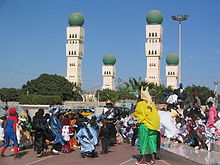

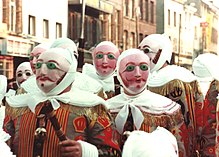
Czech Republic
In the Czech Republic it is a folk tradition to celebrate Mardi Gras, which is called Masopust (meat-fast i.e. beginning of fast there). There are celebration in many places including Prague[9] but the tradition also prevails in the villages such as Staré Hamry, whose the door-to-door processions there made it to the UNESCO World Intangible Cultural Heritage List.[10]
Germany
The celebration on the same day in Germany knows many different terms, such as Schmutziger Donnerstag or Fetter Donnerstag (Fat Thursday), Unsinniger Donnerstag, Weiberfastnacht, Greesentag and others, and are often only one part of the whole carnival events during one or even two weeks before Ash Wednesday be called Karneval, Fasching, or Fastnacht among others, depending on the region. In standard German, schmutzig means "dirty", but in the Alemannic dialects schmotzig means "lard" (Schmalz), or "fat";[11] "Greasy Thursday", as remaining winter stores of lard and butter used to be consumed at that time, before the fasting began. Fastnacht means "Eve of the Fast", but all three terms cover the whole carnival season. The traditional start of the carnival season is on 11 November at 11:11 am (11/11 11:11).
Italy
In Italy Mardi Gras is called Martedì Grasso (Fat Tuesday). It's the main day of Carnival along with the Thursday before, called Giovedí Grasso (Fat Thursday), which ratifies the start of the celebrations. The most famous Carnivals in northern Italy are in Venice, Viareggio and Ivrea, while in the southern part of Italy the Sardinian Sartiglia and the intriguing apotropaic masks, especially the mamuthones, issohadores, s'urtzu (and so on), are more popular, belonging to a very ancient tradition. Ivrea has the characteristic "Battle of Oranges" that finds its roots in medieval times. The Italian version of the festival is spelled Carnevale.[12]
Sweden
In Sweden the celebration is called Fettisdagen, when fastlagsbulle is eaten, more commonly called Semla. The name comes from the words "fett" (fat) and "tisdag" (Tuesday). Originally, this was the only day one should eat fastlagsbullar.[13]
United States
While not observed nationally throughout the United States, a number of traditionally ethnic French cities and regions in the country have notable celebrations. Mardi Gras arrived in North America as a French Catholic tradition with the Le Moyne brothers,[14] Pierre Le Moyne d'Iberville and Jean-Baptiste Le Moyne de Bienville, in the late 17th century, when King Louis XIV sent the pair to defend France's claim on the territory of Louisiane, which included what are now the U.S. states of Alabama, Mississippi, Louisiana and part of eastern Texas.[14]
The expedition, led by Iberville, entered the mouth of the Mississippi River on the evening of 2 March 1699 (new style), Lundi Gras. They did not yet know it was the river explored and claimed for France by René-Robert Cavelier, Sieur de La Salle in 1683. The party proceeded upstream to a place on the east bank about 60 miles (100 km) downriver from where New Orleans is today, and made camp. This was on 3 March 1699, Mardi Gras, so in honour of this holiday, Iberville named the spot Point du Mardi Gras (French: "Mardi Gras Point") and called the nearby tributary Bayou Mardi Gras.[15] Bienville went on to found the settlement of Mobile, Alabama in 1702 as the first capital of French Louisiana.[16] In 1703 French settlers in Mobile established the first organised Mardi Gras celebration tradition in what was to become the United States.[14][17][18][19] The first informal mystic society, or krewe, was formed in Mobile in 1711, the Boeuf Gras Society.[17] By 1720, Biloxi had been made capital of Louisiana. The French Mardi Gras customs had accompanied the colonists who settled there.[14]
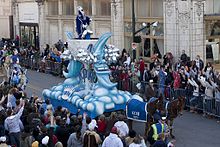
In 1723, the capital of Louisiana was moved to New Orleans, founded in 1718.[16] The first Mardi Gras parade held in New Orleans is recorded to have taken place in 1837. The tradition in New Orleans expanded to the point that it became synonymous with the city in popular perception, and embraced by residents of New Orleans beyond those of French or Catholic heritage. Mardi Gras celebrations are part of the basis of the slogan Laissez les bons temps rouler ("Let the good times roll").[14][failed verification] On Mardi Gras Day, the Tuesday before Ash Wednesday, the last parades of the season wrap up and the celebrations come to a close with the Meeting of the Courts (known locally as the Rex Ball). Other cities along the Gulf Coast with early French colonial heritage, from Pensacola, Florida; Galveston, Texas; to Lake Charles and Lafayette, Louisiana; and north to Natchez, Mississippi and Alexandria, Louisiana, have active Mardi Gras celebrations.
Galveston's first recorded Mardi Gras celebration, in 1867, included a masked ball at Turner Hall (Sealy at 21st St.) and a theatrical performance from Shakespeare's "King Henry IV" featuring Alvan Reed (a justice of the peace weighing in at 350 pounds!) as Falstaff. The first year that Mardi Gras was celebrated on a grand scale in Galveston was 1871 with the emergence of two rival Mardi Gras societies, or "Krewes" called the Knights of Momus (known only by the initials "K.O.M.") and the Knights of Myth, both of which devised night parades, masked balls, exquisite costumes and elaborate invitations. The Knights of Momus, led by some prominent Galvestonians, decorated horse-drawn wagons for a torch lit night parade. Boasting such themes as "The Crusades," "Peter the Great," and "Ancient France," the procession through downtown Galveston culminated at Turner Hall with a presentation of tableaux and a grand gala.
In the rural Acadiana area, many Cajuns celebrate with the Courir de Mardi Gras, a tradition that dates to medieval celebrations in France.[20]
St. Louis, Missouri, founded in 1764 by French fur traders, claims to host the second largest Mardi Gras celebration in the United States.[21] The celebration is held in the historic French neighborhood, Soulard, and attracts hundreds of thousands of people from around the country.[22] Although founded in the 1760s, the St. Louis Mardi Gras festivities only date to the 1980s.[23] The city's celebration begins with "12th night," held on Epiphany, and ends on Fat Tuesday. The season is peppered with various parades celebrating the city's rich French Catholic heritage.[24]
Costumes

Mardi Gras, as a celebration of life before the more-somber occasion of Ash Wednesday, nearly always involves the use of masks and costumes by its participants, and the most popular celebratory colors are purple, green, and gold. In New Orleans, for example, these often take the shape of fairies, animals, people from myths, or various Medieval costumes[25] as well as clowns and Indians (Native Americans).[26] However, many costumes today are simply elaborate creations of colored feathers and capes. Unlike Halloween costumery, Mardi Gras costumes are not usually associated with such things as zombies, mummies, bats, blood, and the like, though death may be a theme in some. The Venice tradition has brought golden masks into the usual round of costumes.[27]
Exposure by women

Women exposing their breasts during Mardi Gras in New Orleans, US, has been documented since 1889, when the Times-Democrat decried the "degree of immodesty exhibited by nearly all female masqueraders seen on the streets." The practice was mostly limited to tourists in the upper Bourbon Street area.[28][29] In the crowded streets of the French Quarter, generally avoided by locals on Mardi Gras Day, flashers on balconies cause crowds to form on the streets.
In the last decades of the 20th century, the rise in producing commercial videotapes catering to voyeurs helped encourage a tradition of women baring their breasts in exchange for beads and trinkets. Social scientists studying "ritual disrobement" found, at Mardi Gras 1991, 1,200 instances of body-baring in exchange for beads or other favors.[29]
See also
- Carnaval de Ponce
- Fat Thursday, a similar traditional Christian feast associated with the celebration of Carnival.
- Maslenitsa
- Shrove Tuesday
- Sydney Gay and Lesbian Mardi Gras
- Soulard
- Tsiknopempti
- Užgavėnės
References
- ^ Jump up to: a b Melitta Weiss Adamson, Francine Segan (2008). Entertaining from Ancient Rome to the Super Bowl. ABC-CLIO. ISBN 9780313086892.
In Anglican countries, Mardis Gras is known as Shrove Tuesday—from shrive meaning "confess"—or Pancake Day—after the breakfast food that symbolizes one final hearty meal of eggs, butter, milk and sugar before the fast. On Ash Wednesday, the morning after Mardi Gras, repentant Christians return to church to receive upon the forehead the sign of the cross in ashes.
- ^ "9 Things You May Not Know About Mardi Gras". History. Retrieved 8 January 2019.
- ^ "The Julian calendar takes effect for the first time on New Year's Day". History.com. 21 July 2010. Retrieved 17 February 2021.
- ^ "Saturnalia". History.com. 5 December 2017. Retrieved 17 February 2021.
- ^ Jump up to: a b c "Mardi Gras Terminology". Mobile Bay Convention & Visitors Bureau. Archived from the original on 9 December 2007. Retrieved 18 November 2007.
- ^ Wilds, John; Charles L. Dufour; Walter G. Cowan (1996). Louisiana, Yesterday and Today: A Historical Guide to the State. Baton Rouge: LSU Press. p. 157. ISBN 978-0807118931. Retrieved 11 December 2015.
- ^ Bratcher, Dennis (7 January 2010). "The Season of Lent". Christian Resource Institute. Retrieved 25 June 2016.
- ^ "Mobile Carnival Association, 1927", MardiGrasDigest.com, 2006, webpage: mardigrasdigest-Mobile "Archived copy". Archived from the original on 7 March 2006. Retrieved 12 March 2018.CS1 maint: archived copy as title (link)
- ^ "Mardi Gras in Bohemia-Prague". Retrieved 18 January 2016.
- ^ "Staročeský masopust Hamry". Retrieved 16 December 2017.
- ^ "Woher hat der Schmutzige Donnerstag seinen Namen?". Regionalzeitung Rontaler AG (in German). 17 February 2013. Retrieved 7 February 2015.
- ^ Killinger, Charles L. (2005). Culture and Customs of Italy. Greenwood Publishing Group. p. 94. ISBN 978-0313324895.
mardi gras in italy.
- ^ "Swedish semla: more than just a bun". Sweden.se. Archived from the original on June 6, 2011. Retrieved February 22, 2011.
- ^ Jump up to: a b c d e "New Orleans & Mardi Gras History Timeline " (event list), Mardi Gras Digest, 2005, webpage: MG-time Archived 24 November 2010 at the Wayback Machine
- ^ "9 Things You May Not Know About Mardi Gras". History.com. Retrieved 17 August 2017.
- ^ Jump up to: a b "Timeline 18th Century:" (events), Timelines of History, 2007, webpage: TLine-1700-1724: on "1702–1711" of Mobile.
- ^ Jump up to: a b "Carnival/Mobile Mardi Gras Timeline". Museum of Mobile. Museum of Mobile. Retrieved 18 July 2012.
- ^ "Mardi Gras in Mobile" (history), Jeff Sessions, Senator, Library of Congress, 2006, webpage: LibCongress-2665.
- ^ "Mardi Gras" (history), Mobile Bay Convention & Visitors Bureau, 2007, webpage: MGmobile.
- ^ Barry Jean Ancelet (1989). Capitaine, voyage ton flag : The Traditional Cajun Country Mardi Gras. Center for Louisiana Studies, University of Southwestern Louisiana. ISBN 0-940984-46-6.
- ^ Geiling, Natasha. "Best Places to Celebrate Mardi Gras Outside of New Orleans". Smithsonian. Retrieved 11 February 2018.
- ^ Houser, Dave G. "7 big Mardi Gras celebrations (not in New Orleans)". chicagotribune.com. Retrieved 11 February 2018.
- ^ "Mardi Gras in St. Louis' Soulard Neighborhood". Retrieved 12 February 2018.
- ^ "12th Night | Soulard Mardi Gras 2018". stlmardigras.org. St. Louis, MO. Retrieved 11 February 2018.
- ^ Lisa Gabbert (1999). Mardi Gras: A City's Masked Parade. The Rosen Publishing Group. p. 4. ISBN 978-0-8239-5337-0.
- ^ A Mardi Gras Dictionary. Pelican Publishing. p. 6. ISBN 978-1-4556-0836-2.
- ^ J.C. Brown (2008). Carnival Masks of Venice: A Photographic Essay. AAPPL Artists & Photographers Press, Limited. ISBN 978-1-904332-83-1.
- ^ Sparks, R. “American Sodom: New Orleans Faces Its Critics and an Uncertain Future”. La Louisiane à la dérive. The École des Hautes Études en Sciences Sociales Coloquio. 16 December 2005.
- ^ Jump up to: a b Shrum, W. and J. Kilburn. "Ritual Disrobement at Mardi Gras: Ceremonial Exchange and Moral Order". Social Forces, Vol. 75, No. 2. (Dec. 1996), pp. 423–458.
External links
| Wikimedia Commons has media related to Mardi Gras. |
- Traditional Cajun Mardi Gras Celebrations
- Mardi Gras in Mobile, Encyclopedia of Alabama
- Where to Celebrate Mardi Gras Around the World – slideshow by The Guardian
- Fashion plates featuring historic Mardi Gras costumes from the Metropolitan Museum of Art Libraries
- Mardi Gras
- Tuesday observances
- February observances
- March observances
- Holidays based on the date of Easter
- Catholic Church in the United States
- Clothing-optional events
